by Brian Hioe
語言:
English
Photo Credit: Brian Hioe
GOING INTO 2018 local elections tomorrow, it is a question as to what will become of Taiwan’s so-called “Third Force”. “Third Force” as a term refers to political parties which emerged after the 2014 Sunflower Movement, composed in large part out of young people, youth candidates, and activists turned politician, and which framed themselves as breaking from establishment politics both DPP and KMT.
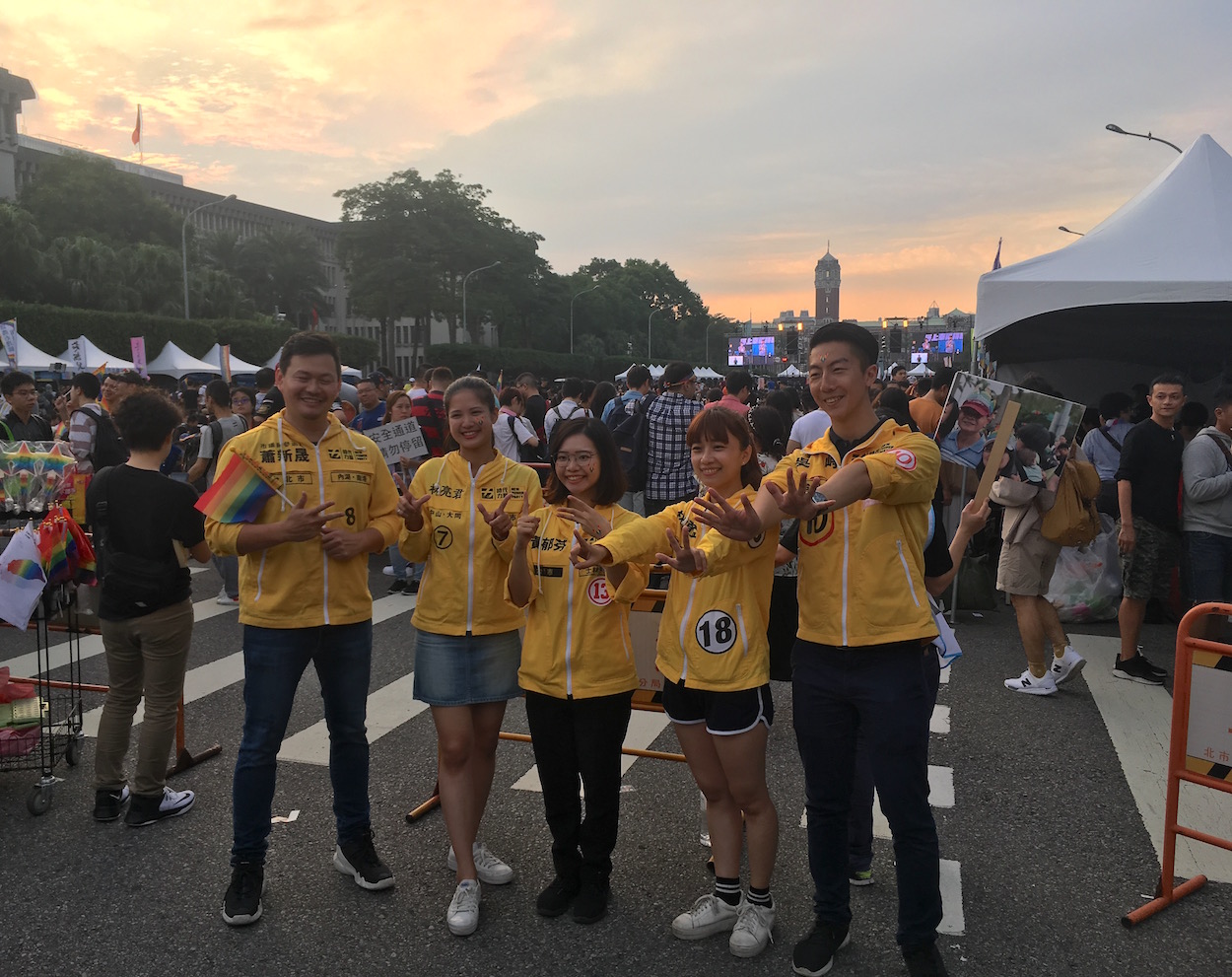 The NPP’s five Taipei candidates at the rally for marriage equality held on Ketagalan Boulevard last Saturday. Photo credit: Brian Hioe
The NPP’s five Taipei candidates at the rally for marriage equality held on Ketagalan Boulevard last Saturday. Photo credit: Brian Hioe
While projects to form Third Force parties predated the Sunflower Movement in some cases, the rise of “Third Force” parties was also influenced by independent Taipei mayoral candidate Ko Wen-Je’s 2014 election victory. Ko’s victory, which was conducted with the support of post-Sunflower Movement youth activists, seemed to indicate that it was possible for independent political candidates to win major election victories. This was inspiring of other attempts to seek political office.
“Third Force” parties such as the New Power Party (NPP), Social Democratic Party (SDP), Free Taiwan Party (FTP), Trees Party, and Radical Wings Party fielded candidates for the legislature in 2016 elections. The results of 2016 elections, however, left only the NPP as having gotten into the legislature.
In 2018 local elections, NPP is now in the middle of an aggressive campaign to expand, fielding 40 candidates this year. This makes the NPP the third party in Taiwan which is fielding the most candidates by far, fielding around 1/10th the number of candidates of both the DPP and KMT, which are fielding around 400 candidates each. The NPP decided not to work with other Third Force parties, but to instead field its own candidates across all of Taiwan, with the explicit aim of being able to become a party large enough to compete with the DPP on an equal basis.
 The NPP’s map of its candidates across all of Taiwan. Photo credit: 時代力量/Facebook
The NPP’s map of its candidates across all of Taiwan. Photo credit: 時代力量/Facebook
Some Third Force parties have receded from importance, while other Third Force parties which are still running in 2018 local elections but were not successful in 2016 have rethought their strategy.
The SDP, for example, which is generally viewed as the second most prominent Third Force party after the NPP, is running six candidates this time, as compared to eleven candidates in 2016. Some of these candidates, such as Miao Poya, previously ran for legislature but have now “downgraded” themselves to running as city council candidates. The SDP is also no longer working with the Green Party, having formed a political alliance with the Greens for the sake of elections in 2016, likely due to tensions between the two internally.
The Radical Wings party was also unsuccessful in getting any of its candidates into office in 2016, having then run as part of the Taiwan Solidarity Union. Nevertheless, the party has clearly increased in size, fielding twelve as compared to five candidates this time. The party has also renamed itself from the “Radical Wings” (基進側翼) party to the “Radical Party” (激進黨). Uniquely of the Third Force parties, which tend to have their strongest base in Taipei, the Radical Party is seen as having a powerful base in southern Taiwan.
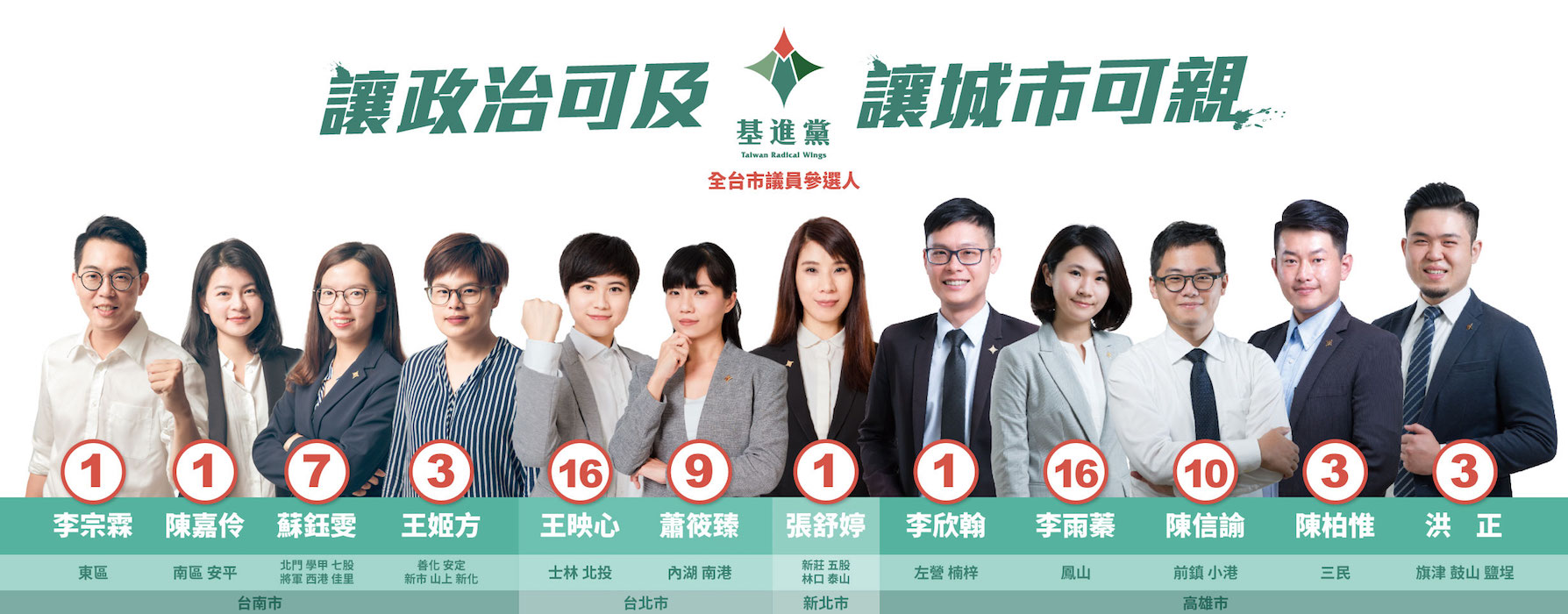 The Radical Party’s slate of candidates across all of Taiwan. Photo credit: 基進黨(基進側翼)/Facebook
The Radical Party’s slate of candidates across all of Taiwan. Photo credit: 基進黨(基進側翼)/Facebook
New political forces have emerged, such as the Obasan Alliance, which is not a formal political party, but an alliance of 21 independent candidates who are mostly middle-aged women, hence the name “Obasan Alliance” from “Obasan”, the Japanese term widely used in Taiwan as a way of referring to middle-aged women. The Obasan Alliance emerged from Parents Participating in Education (親子共學促進會), a progressive group of parents active in civil society issues. It remains to be seen if a high-risk strategy of fielding 21 candidates, a large number of candidates for an organization with limited resources and without a preexistent formal organizational framework, will pay off. Other third parties formations, too, have emerged, such as the Left Party (左翼黨), but might not necessarily be characterized as “Third Force” given that the “Third Force” tends to lean in the direction of Taiwanese independence and the Left Party is primarily composed of pro-independence leftist candidates.
No Third Force parties have decided to field mayoral candidates, instead keeping their eyes on winning city council seats. There was speculation that Huang Kuo-Chang of the NPP would seek to run for New Taipei city mayor, particularly if he was successfully recalled from office by anti-gay groups that begrudged his strong support of marriage equality, or that Freddy Lim of the NPP might run for Taipei city mayor. But this proved to simply be speculation.
Likewise, Fan Yun of the SDP announced a mayoral run in May 2018 but then announced that she would not be running in August 2018, citing the prohibitive expense of the 2 million NTD deposit required for a mayoral run. Tsay Ting-Kuei of the FTP also announced a mayoral run because of the FTP’s criticisms of current Taipei mayor Ko Wen-Je for his perceived increasing political closeness with China and the pan-Blue camp, but Tsai also does not appear to have followed through with this. It appears that for now, running for mayor is not on the table for the Third Force, given the high expenses. These mayoral runs may have primarily been political stunts, at least Fan likely have declared a mayoral run in order to call attention to these prohibitive barriers.
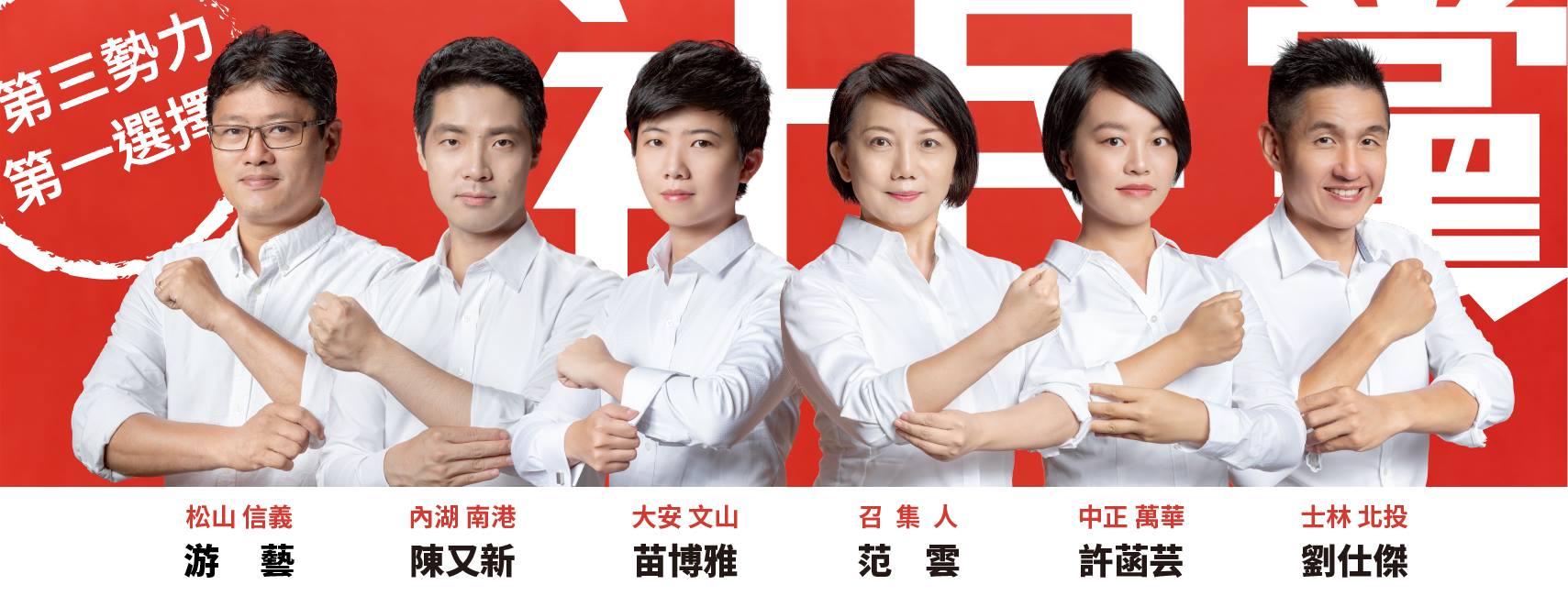 The Social Democratic Party’s slate of candidates, which are all Taipei-based. Photo credit: 社會民主黨/Facebook
The Social Democratic Party’s slate of candidates, which are all Taipei-based. Photo credit: 社會民主黨/Facebook
It is unknown what would happen if Third Force parties are generally defeated. Though now seems like a make or break moment, in which Third Force parties may fade out of existence if they do badly in this year’s election, it is unknown whether Third Force parties are spending all of their resources on 2018 elections or are retaining resources for 2020 elections, which are actually only 14 months away and not two years away. Third Force figures who decided to not run for city council despite that they ran in 2016, such as SDP chair Fan Yun, or Radical Party chair Shinichi Chen, may be saving themselves up for another run at the legislature in 2020.
Third Force parties that currently do not have any political seats do face the strong possibility of political irrelevance if they are unsuccessful in this current set of elections. In truth, despite that it is the Third Force party with the most resources by far if the NPP does badly, it also faces this threat. Yet there are precedents for third parties in Taiwan being able to survive and field candidates in subsequent elections after strong defeats, such as with the Taiwan Solidarity Union, or pan-Blue splinter parties as the New Party and People First Party. But the political momentum of the Third Force could be broken and they could be relegated to permanently being fringe parties with no chances of growth.
As with 2016, the biggest divide among Third Force parties continues to be the question of what political forces that they ally with. The NPP took flak from other Third Force parties in 2016 by working together with the DPP in elections. The DPP decided to not run its own candidates in the districts where NPP candidates were running, not only as a means of trying to co-opt youth activists after the Sunflower Movement but because the DPP wished to present itself as though it carried forward the demand for political change expressed by young people after the movement.
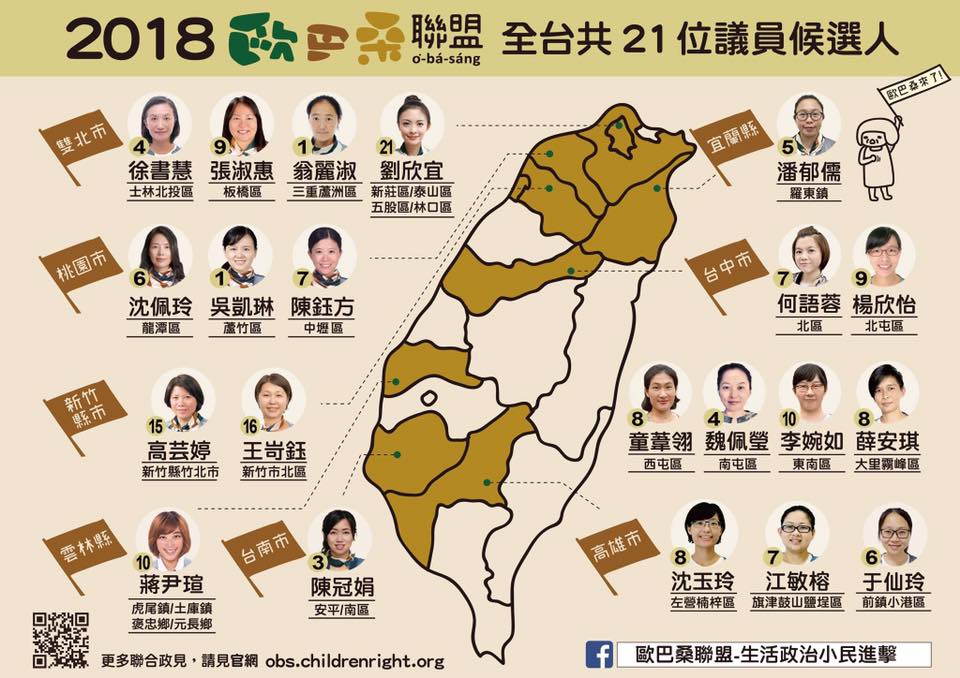 The Obasan Alliance’s slate of candidates across all of Taiwan. Photo credit: 歐巴桑聯盟-生活政治小民進擊/Facebook
The Obasan Alliance’s slate of candidates across all of Taiwan. Photo credit: 歐巴桑聯盟-生活政治小民進擊/Facebook
This time around, though competing directly with the DPP, the NPP has seen flak for not aligning with other Third Force parties in any form of alliance, and because some NPP candidates endorsed Taipei mayor Ko Wen-Je in his reelection bid. This is controversial because, again, Ko is seen as having drifted increasingly close to China and the pan-Blue camp in the past four years. NPP candidates are accused of political opportunism in hoping to benefit from Ko’s endorsement, as Ko is currently one of the most popular politicians in Taiwan.
Significantly, the NPP evidenced internal divides over the issue. Counterintuitively, though, this may actually be taken as a sign of growth by the party, seeing as the party is now large enough to entertain multiple political tendencies. It is a shift for the party’s internal culture that the party leadership has expressed a willingness to entertain multiple tendencies within the party, though there have long been rumors of tense relations between NPP chair Huang Kuo-Chang and Freddy Lim, the party’s other powerhouse politician.
At the same time, it is probably true that no Third Force party has not made some form of compromises before. In 2016 elections, the NPP was initially open to working together with the SDP, as observed in that then-legislative candidate Freddy Lim backed out of his original plan to run in Daan to make way for SDP chair Fan Yun after she declared that she would be running in the area. Likewise, despite attempting to distinguish itself from the NPP by not seeking the endorsement of the DPP, the SDP was perceived as selling out its fellow Third Force party, the NPP, because Fan Yun endorsed DPP majority speaker Ker Chien-ming over NPP candidate Handy Chiu.
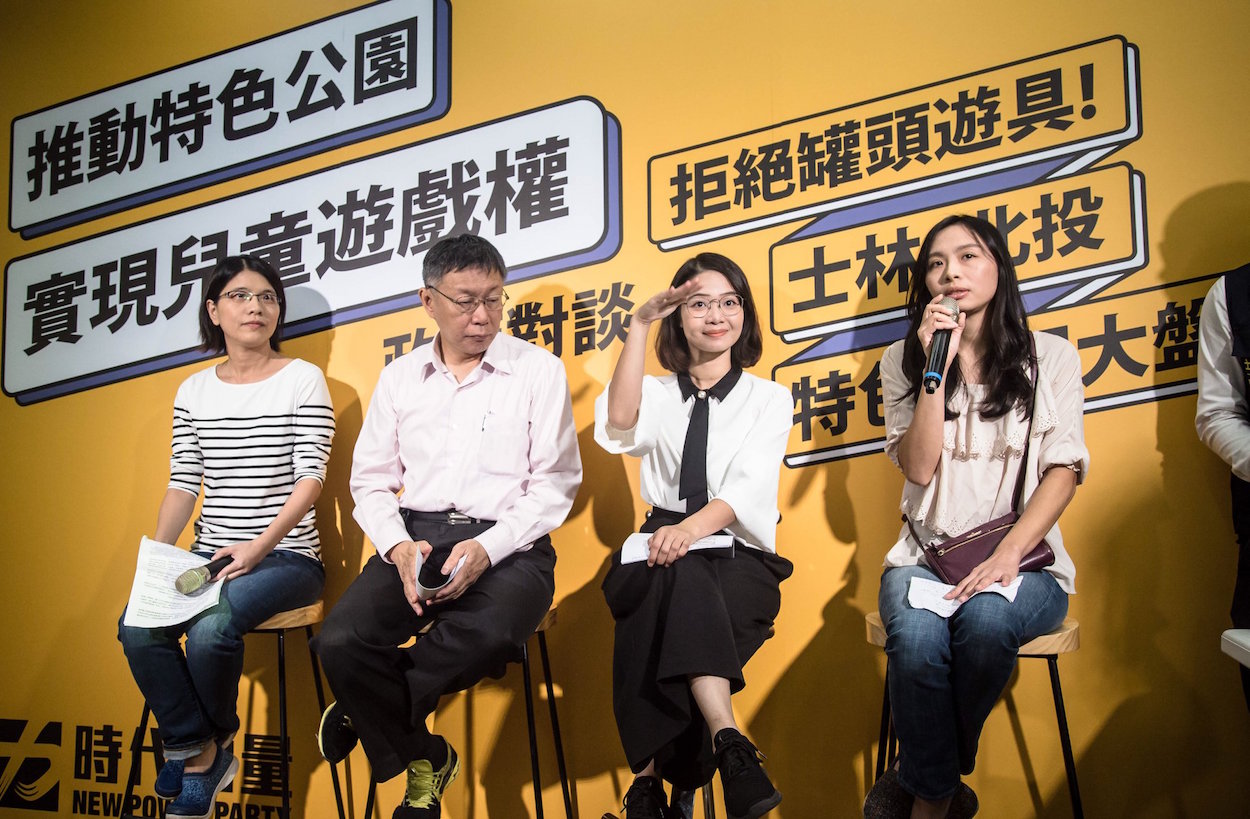 NPP candidate Meredith Huang (center) and Taipei mayor Ko Wen-je (left). Photo credit: 黃郁芬 士林北投加分/Facebook
NPP candidate Meredith Huang (center) and Taipei mayor Ko Wen-je (left). Photo credit: 黃郁芬 士林北投加分/Facebook
Overall, the future of the Third Force remains to be seen. NPP chair Huang Kuo-chang has, for one, stated that he hopes to win at least 20 seats across Taiwan. As the NPP does not have the DPP endorsement this time and it has always been an open question as to how much the NPP required the DPP endorsement in order to be successful in 2014, even if the party’s public image was founded on being different from establishment politics both DPP and KMT, this will be a genuine test of the NPP’s ability to stand independently from the DPP.
While, again, it is a question as to whether the NPP or other Third Force parties could survive in the event of defeat, one notes that there has been some movement between Third Force parties, as in former SDP-Green Alliance candidate Zeng Po-yu running as part of the NPP this time. It is possible that even if other smaller Third Force parties are wiped out in this set of elections, their members could join with the NPP eventually, if the NPP decides to allow them to join. If the NPP absorbs the Third Force, this might push them into more of a united front, though this might also accentuate the tendency towards factionalization within the party. It is likely that lasting grudges would prevent some from joining or the NPP may not actually wish to open itself to outsiders who already have political reputations of their own, because this could radically alter the internal dynamics of the party. This remains to be seen.

